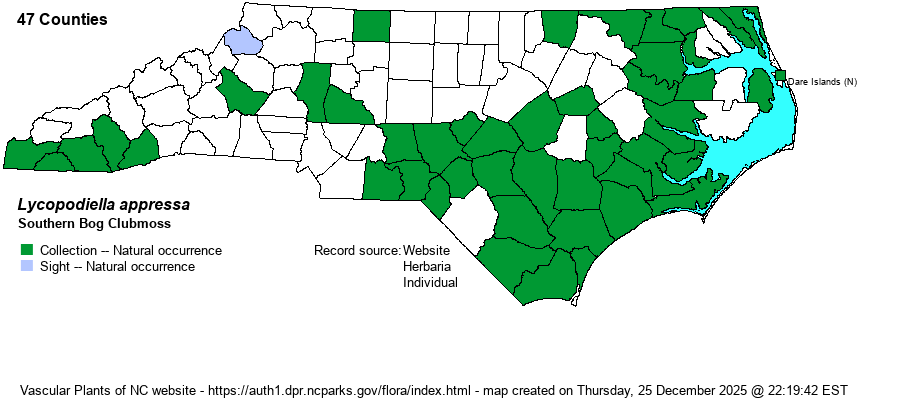| Author | (Chapman) Cranfill | |
| Distribution | Present over essentially all of the Coastal Plain, and widely scattered in the Piedmont and Mountains. West of the Coastal Plain, found mainly in the southern parts of the Piedmont and Mountains.
This is a primarily Coastal Plain species, ranging from Newf. and N.S. south to ME, KY, and southeastern OK, south to southern FL and central TX. | |
| Abundance | Fairly common to common in the southern third of the Coastal Plain; infrequent to fairly common in much of the central and northern portions. Very rare in the Piedmont, and rare in the southern Mountains. Casual in the northern Mountains. The State Rank perhaps can be moved to S5, though S4 is certainly not incorrect. | |
| Habitat | This species has similar habitats to the other Coastal Plain species in the genus -- moist to wet, acidic soils of pinelands, such as pine savannas, wet pine flatwoods, ditches, seepages, streamhead pocosin margins, margins of beaver ponds and artificial lakes, and other damp sandy places. It occurs in bogs in the Mountains. | |
| Phenology | Fruits from July to September. | |
| Identification | This species is similar to others in the genus and to Pseudolycopodiella caroliniana, in that it has a prostrate stem with numerous mostly appressed linear leaves, with scattered vertical stems carrying the strobili. In this species, the numerous linear, scale-like leaves that cover the fertile (vertical) stem are short (only 2.9-5.0 mm) long, much shorter than in the other two members of Lycopodiella, and they are erectly appressed; in addition, the strobili are narrower than the others, only 3-6 mm in width. The other two species have much broader-looking fertile stems and strobili. Pseudolycopodiella also has a narrow-looking fertile stem, but it has relatively few leaves, and these are in whorls; plus its sterile leaves are relatively broad and this stem has a strongly flattened look owing to short upper leaves (compared with the long lateral ones). NOTE: This species occasionally hybridizes with L. alopecuroides; the offspring are robust like the latter and have been given the name L. x copelandii. For ID, consult technical manuals or see Snyder & Bruce (1986) Guide to Ferns of Georgia, which has excellent drawings. | |
| Taxonomic Comments | This species was formerly named as Lycopodium appressum. Note that it is an entirely different species than Huperzia appressa.
| |
| Other Common Name(s) | Appressed Bog Clubmoss | |
| State Rank | S4 [S5] | |
| Global Rank | G5 | |
| State Status | | |
| US Status | | |
| USACE-agcp | OBL link |
| USACE-emp | FACW link |

